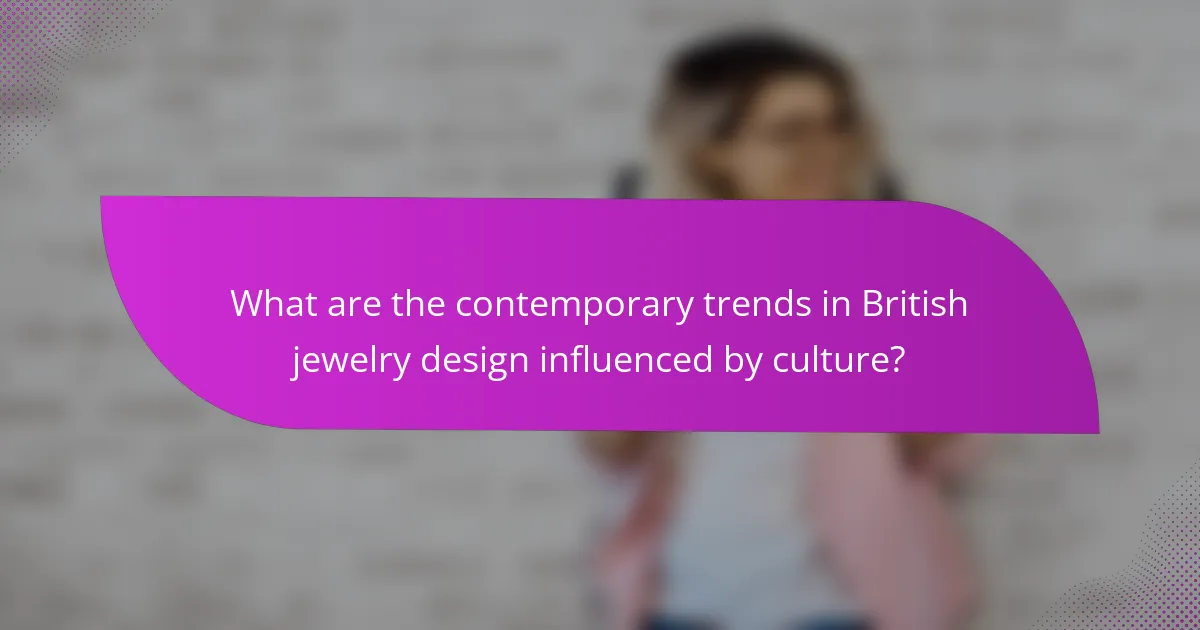British jewelry design is shaped by a multitude of cultural influences, including historical events, artistic movements, and regional traditions. The Victorian era and the Arts and Crafts movement significantly impacted design aesthetics, emphasizing craftsmanship and symbolism. Contemporary trends highlight cultural diversity and sustainability, with designers incorporating multicultural elements and ethical practices. Symbolism plays a crucial role, with jewelry pieces often conveying personal and cultural narratives through motifs and materials. This article explores the intricate relationship between cultural influences and the evolution of British jewelry design, showcasing the rich tapestry of styles and meanings embedded within each piece.

What are the cultural influences on British jewelry design?
British jewelry design is influenced by various cultural factors. Historical events, such as the Victorian era, shaped design aesthetics and materials. The Arts and Crafts movement emphasized handmade craftsmanship and natural motifs. Cultural diversity from colonial influences introduced exotic materials and styles. Art Deco brought geometric designs and modernist elements into British jewelry. Regional traditions, like Celtic designs, contribute unique patterns and symbolism. Global fashion trends also impact contemporary British jewelry design. Collectively, these influences create a rich tapestry of styles in British jewelry.
How do historical events shape British jewelry design?
Historical events significantly influence British jewelry design. For instance, the Victorian era introduced intricate designs reflecting social changes. The Industrial Revolution allowed mass production, making jewelry more accessible. World War I and II led to resource shortages, prompting simpler designs. The Art Deco movement in the 1920s showcased geometric shapes and bold colors, influenced by global trends. The rise of the British royal family also impacted styles, with royal weddings sparking trends. Each of these historical moments contributed distinct elements to the evolution of British jewelry design.
What specific historical events have had the most impact?
The Industrial Revolution significantly impacted British jewelry design. It introduced mass production techniques, allowing for the creation of jewelry on a larger scale. This period saw the rise of new materials, such as steel and glass, which were incorporated into designs. The Great Exhibition of 1851 showcased British craftsmanship and innovation in jewelry. The Victorian era emphasized sentimental and nature-inspired designs, reflecting societal values. World War I shifted trends towards more practical and simpler styles due to economic constraints. The 1960s brought about a cultural revolution, influencing jewelry with bold and unconventional designs. Each of these events shaped the evolution of jewelry in Britain, reflecting broader cultural changes.
How do these events reflect in design styles?
Cultural events significantly influence design styles in British jewelry. Historical events shape the themes, materials, and techniques used by designers. For instance, the Victorian era saw the use of sentimental motifs, reflecting societal values of love and remembrance. The Art Deco movement introduced geometric patterns and bold colors, mirroring the modernist trends of the 1920s. Additionally, cultural events like the World Wars impacted jewelry design by introducing materials like plastic and promoting utility. Designers often draw inspiration from global events, incorporating diverse cultural elements into their work. This fusion creates unique pieces that resonate with contemporary audiences while honoring tradition.
In what ways do cultural diversity and immigration influence jewelry design?
Cultural diversity and immigration significantly shape jewelry design through the introduction of varied styles and techniques. Different cultures bring unique materials, symbols, and craftsmanship methods. For example, Indian jewelry often features intricate beadwork and vibrant colors, while Scandinavian designs emphasize minimalism and natural elements.
Immigrants contribute to the local jewelry market by incorporating their heritage into contemporary designs. This fusion creates innovative pieces that reflect a blend of traditions. The global exchange of ideas enhances creativity in the jewelry industry.
Moreover, cultural festivals and celebrations inspire seasonal jewelry collections. Designers often draw on cultural motifs to create meaningful pieces that resonate with diverse audiences. This influence is evident in the rise of multicultural jewelry brands that celebrate inclusivity.
Overall, cultural diversity and immigration enrich jewelry design, fostering a dynamic and evolving artistic landscape.
What cultural elements are incorporated into British jewelry?
British jewelry incorporates various cultural elements, reflecting the nation’s rich history and diversity. Traditional British symbols, such as the rose, thistle, and shamrock, are commonly featured. These symbols represent England, Scotland, and Ireland, respectively. Additionally, Victorian influences are evident in intricate designs and the use of gemstones. Art Deco styles also play a significant role, showcasing geometric patterns and bold colors. The incorporation of Celtic motifs highlights the influence of ancient traditions. Furthermore, contemporary British jewelry often embraces multiculturalism, integrating designs from various global influences. This fusion creates a unique blend of styles that defines British jewelry today.
How do immigrant communities contribute to design innovation?
Immigrant communities contribute to design innovation by introducing diverse cultural perspectives and techniques. Their unique backgrounds enrich the design process with new ideas and aesthetics. For instance, immigrants often blend traditional craftsmanship with contemporary trends. This fusion results in innovative jewelry designs that appeal to a broader audience. Research from the Design Council highlights that diverse teams produce more creative solutions. Additionally, immigrant artisans often revive and reinterpret cultural motifs, creating distinctive pieces. This cultural exchange fosters originality in British jewelry design.

How does symbolism play a role in British jewelry design?
Symbolism is integral to British jewelry design, often conveying cultural narratives and personal meanings. Jewelry pieces frequently incorporate symbols such as hearts, crosses, and animals to represent love, faith, or heritage. For example, the use of the thistle symbolizes Scotland’s national identity. Historical movements, such as the Arts and Crafts movement, emphasized symbolism to reflect craftsmanship and individuality. Additionally, Victorian jewelry often featured symbolism to communicate emotions, such as mourning or affection, through motifs like locks of hair or specific gemstones. This symbolic language enriches the storytelling aspect of jewelry, making each piece a representation of deeper values and beliefs.
What common symbols are found in British jewelry?
Common symbols found in British jewelry include the rose, thistle, and shamrock. The rose represents England and symbolizes love and beauty. The thistle is a symbol of Scotland, representing resilience and determination. The shamrock signifies Ireland and is associated with luck and prosperity. Other symbols include the crown, which denotes royalty, and the lion, representing strength and courage. These symbols reflect the cultural heritage and national identity of the British Isles. They are often incorporated into designs to celebrate historical and regional significance.
How do these symbols relate to cultural heritage?
Symbols are integral to cultural heritage as they convey shared values and beliefs. In British jewelry design, symbols often reflect historical events, social status, and regional identity. For example, the use of Celtic knots represents the interconnectedness of life and eternity in Celtic culture. Additionally, symbols like the crown signify royal heritage and authority. These elements serve to connect individuals to their ancestry and cultural narratives. Historical records show that symbols in jewelry have been used for centuries to express personal and collective identities. Thus, symbols in British jewelry design are vital in preserving and communicating cultural heritage.
What meanings do these symbols convey to wearers?
Symbols in jewelry convey various meanings to wearers, often representing personal beliefs or cultural heritage. For example, a heart symbol signifies love and affection. An infinity symbol represents eternity and everlasting connections. Additionally, religious symbols, like crosses or stars, express faith and spiritual identity. Cultural motifs may signify heritage or community belonging. Each symbol can evoke emotional responses, shaping the wearer’s identity and social connections. These meanings can vary significantly across different cultures and personal experiences. Historical contexts also influence how symbols are interpreted, adding layers of significance.
Why is craftsmanship significant in the context of cultural influences?
Craftsmanship is significant in the context of cultural influences because it embodies the values and traditions of a society. It reflects the historical context, techniques, and materials unique to a culture. In British jewelry design, craftsmanship showcases the artistry and skill passed down through generations. This expertise often incorporates cultural symbols and narratives. For example, the use of specific motifs can signify regional identity. Craftsmanship also responds to evolving cultural trends, adapting while preserving heritage. The attention to detail in handmade pieces highlights cultural pride. Thus, craftsmanship serves as a bridge connecting past and present cultural expressions.
What traditional techniques are preserved in British jewelry making?
Traditional techniques preserved in British jewelry making include enameling, granulation, and stone setting. Enameling involves fusing glass to metal for decorative effects. This technique dates back to the medieval period in Britain. Granulation is the process of fusing small metal beads to create intricate designs. This method has roots in ancient jewelry making and remains popular. Stone setting refers to securely placing gemstones in metal settings. Techniques like bezel and prong setting are commonly used. These traditional methods reflect Britain’s rich cultural heritage in craftsmanship. Each technique showcases the skill and artistry of British jewelers throughout history.
How do contemporary artisans blend tradition with modern design?
Contemporary artisans blend tradition with modern design by integrating historical techniques with contemporary aesthetics. They often use traditional materials like gold and silver while experimenting with new forms and styles. This fusion creates unique pieces that honor heritage yet appeal to modern sensibilities. Artisans may draw inspiration from cultural motifs and historical craftsmanship. They adapt these elements to fit current trends and consumer preferences. For instance, many incorporate minimalist designs that resonate with today’s fashion. Additionally, artisans may utilize advanced technology for production, enhancing precision while preserving artisanal quality. This approach reflects a commitment to both legacy and innovation in jewelry design.

What are the contemporary trends in British jewelry design influenced by culture?
Contemporary trends in British jewelry design are significantly influenced by cultural diversity and sustainability. Designers are increasingly incorporating multicultural elements into their pieces. This includes the use of traditional motifs from various cultures. There is also a focus on ethical sourcing and sustainable materials. Many British jewelers are now prioritizing eco-friendly practices. The rise of personalization in jewelry reflects individual cultural identities. Additionally, collaborations with artisans from different backgrounds are becoming more common. These trends highlight the fusion of global influences in British jewelry design.
How are modern cultural movements affecting jewelry styles?
Modern cultural movements are significantly influencing jewelry styles. These movements promote diversity and inclusivity in design. For example, the rise of sustainability has led to eco-friendly materials being favored. Many designers now utilize recycled metals and ethically sourced gemstones. Additionally, social movements emphasize personal expression through unique, customizable pieces.
The popularity of minimalism reflects a shift towards simplicity and functionality in jewelry. This trend is evident in the increasing demand for delicate, understated designs. Conversely, maximalism is gaining traction, showcasing bold colors and intricate patterns.
Cultural heritage plays a crucial role in shaping contemporary jewelry styles. Designers often draw inspiration from traditional motifs and techniques. This blend of old and new creates a rich tapestry of styles that resonate with modern consumers.
Overall, modern cultural movements are reshaping the jewelry landscape, fostering innovation and reflecting societal values.
What trends are emerging from social media and pop culture?
Emerging trends from social media and pop culture include the rise of sustainability and ethical consumption. Consumers increasingly seek brands that prioritize eco-friendly practices. This shift is evident in the popularity of vintage and second-hand jewelry. Social media platforms amplify these trends through influencers promoting sustainable fashion. The hashtag #SustainableFashion gained over 18 million posts on Instagram. Additionally, personalization in jewelry design is becoming prominent. Customizable pieces resonate with younger audiences seeking unique expressions of identity. Trends also show a fusion of traditional and modern designs, reflecting cultural heritage. This blend is often showcased in viral TikTok videos and Instagram reels. Overall, social media is a driving force in shaping consumer preferences in jewelry design.
How do sustainability and ethical considerations influence design choices?
Sustainability and ethical considerations significantly influence design choices in British jewelry. Designers prioritize eco-friendly materials to reduce environmental impact. They often source recycled metals and ethically mined gemstones. This approach aligns with consumer demand for responsible products. Ethical considerations also drive transparency in sourcing practices. Brands that disclose their supply chains gain consumer trust. Additionally, sustainable practices can enhance brand reputation. Research indicates that 66% of consumers are willing to pay more for sustainable brands. This trend encourages designers to innovate while adhering to ethical standards. Overall, sustainability and ethics shape the jewelry design landscape in meaningful ways.
What practical tips can be applied when exploring cultural influences in jewelry design?
Research various cultures to understand their symbolism in jewelry. This knowledge helps in creating meaningful designs. Study traditional techniques and materials used in different cultures. Incorporating these elements can enhance authenticity. Attend cultural events or exhibitions to gain firsthand experience. Engaging with artisans from diverse backgrounds can provide valuable insights. Analyze historical contexts that influenced jewelry styles in specific cultures. This can inform modern interpretations. Collaborate with cultural experts to ensure respectful representation. This approach fosters inclusivity and appreciation for different heritages.
The main entity of the article is British jewelry design, which is shaped by various cultural influences, including historical events, craftsmanship, and diversity. The article explores how significant periods, such as the Victorian era and Art Deco movement, have impacted design aesthetics and materials. It also highlights the role of cultural diversity, immigration, and symbolism in enriching jewelry styles, as well as the importance of sustainability and ethical considerations in contemporary practices. Key sections examine specific historical events, cultural elements, and emerging trends in British jewelry design, emphasizing the dynamic interplay between tradition and modernity.
